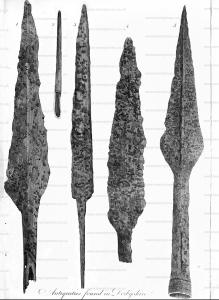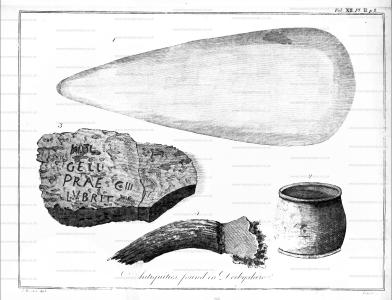Archaeologia Volume 12 Section I
Archaeologia Volume 12 Section I is in Archaeologia Volume 12.
Antiquities discovered in Derbyshire. In a Letter from Hayman Rooke (age 70), Esq. F. S. A. to the Rev. Dr. Pegge (age 89), F. S. A. Read November 21, 1793.

Dear Sir, Mansfield Woodhouse, Dec. 27, 1793.
The following account of some Roman antiquities lately discovered near Hopton [Map], which Mr. Gell was so obliging as to reserve for my inspection, I did intend to have had the honour of presenting to the Society; but, as it will be rendered more acceptable by the addition of your learned observations, I shall solicit for its admittance into your interesting account of Roman antiquities (Derbeiesscira Romana), which I hope you intend to continue. I am, dear Sir,
Your fincere and obliged humble fervant,
H. Rooke.
N° 1. PI. I. is an iron head of a spear, found in a ro mantic valley which extends about three miles, where Mr. Gell is now making a road from Hopton Moor to Ible.
N° 2. appears to be the head of an arrow found near the above.
N° 3. seems to be an iron dagger found in removing the earth in the same valley.
N° 4. an iron head of a spear, much corroded with rust, found in making the new road.
N° 5. is another iron head of a spear the size of the drawing found near the above in June, 1792.
N° 1. PI. II. was found in November, 1791, in the same valley, and about three feet under ground; this very singular-shaped instrument appears to be marble, of a light colour, tinged with yellow, and a mixture of pale red and green veins, and, what is very extraordinary, it still retains a sine polish; the edges are thin, rising gradually to about the thickness of half an inch in the middle; from its shape and size it could not have been used as a weapon, but I think it might very possibly be the instrument used by the Aruspices, who examined the entrails of the victims that were sacrificed, which were always carefully surveyed.

It is very remarkable, that these spear-heads should be found covered with stones three feet below the surface in this sequestered valley, where there are no traces of a Roman road or remains of Roman barrows; but, as Mr. Gell’s letter to me on this subject will be more satisfactory than my conjectures, I shall here fend you a copy of it: "I should not dare to venture a conjecture with any Antiquary excepting yourself, whose candour I have so frequently had occasion to experience, and which I must now trespass upon again by risking an opinion of the means of these implements coming to the strange place where they are discovered; in my almost daily solitary rides down the valley, my thoughts have been almost always employed (when near the place) upon their being found in a situation where it is impossible there could have ever been either camp, station, or habitation of any kind, except, perhaps, an hermitage, where no traveller ever set his foot before the present time; that they should be found here is certainly extraordinary; but, as you have clearly proved that the Romans have been in this neighbourhood, it may be fairly concluded, that, in their attempts to proceed farther, they met with interruptions from the Britons, who, most probably, attacked them in this defile with showers of stones, and this appears to me the most probable method of accounting for these being covered with stones of the size for the purpose of throwing."
About a mile South of the above-mentioned valley, on a rising ground near Hopton, is a very large barrow called Abbot’s Low [Map], the circumference of which is 196 feet. As the labourers were preparing this for a plantation, they discovered an urn, which Mr. Gell was fo obliging as to order should not be touched till I came to Hopton. In May last we proceeded to examine the urn, and after removing the stone, N° 2, which covered it, and clearing away the ground to the depth of five feet from the top, and about eighteen inches below the natural soil, I got a distinct view of the urn, which was four feet three inches in circumference, made of coarse baked earth, and full of burnt bones and ashes, in attempting to take it up, it fell to pieces. See the shape of the urn in drawing N° 3. The stone which covered this urn, fee N° 2, measures on the top two feet fix inches by one foot eight inches, and about nine inches thick, it appears to be a soft yellowish free stone, and much corroded; in rubbing off the dirt from the top, which had filled lip the interfaces of the letters, I discovered an inscription, a facsimile of which is on the stone N° 7. There evidently appears to have been more letters above, but they are now fo defaced by time, that nothing can be made out, though very possibly they might have been the letters of the praenomen; the inscription seems to be intended for Gellius Præfectus Cohortis Tertieæ Legionis Quintæ Britannicæ, but it does not appear, by any Roman author, that the fifth legion was ever in Britain, though Mr. Gordon mentions [a] a stone with the V. legion upon it, found in the fort at Grot hill in Scotland; he says, "I likewife found another very rare and curious stone with the following letters upon it, Leg. V. from the letters, two angular borderings appear on each side of the stone, so close and plain, that it leaves no room to doubt of its being read Legio Quinta; nor is there any space whatsoever for another letter to have been put in. I take this to be an invaluable rarity of its kind, being the only stone that ever I found in the island of Britain with the name of the fifth legion impressed upon it" LEGV.
Note a. Gordon* s Itinerarium Septentrionale, p. 56.
But Horsley feems to be of a different opinion. He says: "But though there be no space between the letters and the angular borderings on each side, yet why may it not be read legio victrix, and by it be meant the legio sexta victrix? which, by the following inscription (Legio sexta victrix fecit) appears to have been at this very sort; as there was no room for VI. and V. (sexta and victrix) it is more likely that the number should be omitted, than the honourable title or epithet; especially since in this case the title would sufficiently distinguish them without the number. Besides, the legio quinta is a legion unheard of in Britain [b]." Hence I think there is great reason to suppose, that this (V) on the stone which covered the urn, was intended for victrices, the title of the Sixth legion, which probably remained fome time in Derbyshire before they marched to the North.
Note b. Horfley's Britannia Romana, p. 200.
The finding of an inscription on a rough undressed stone covering an urn in a barrow, is, I think, a curious discovery, for I do not recollect, in any account that has been written on Urn Burial, or on Sepulchral Inscriptions, that one has been found in a similar situation; it is also remarkable, that the prefect’s name should be Gellius, and that the urn which contained his alses should be deposited in a barrow on Mr. Gell’s estate. Could Mr. Gell’s family be descended from this antient Roman?
The Peak of Derbyshire abounds also with natural curiosities. Drawing N° 3. is part of a remarkable large horn; the pith, or slough, only remains, the horny part being entirely rotted off; circumference at (a) one foot four inches, at (b) one foot ten inches, length from (c). to (d) one foot eight inches; it was found in making the tunnel of the Cromford canal, near Butterly; from the great size this horn must have been of when perfect, I think it cannot be appropriated to any species of animals now extant in this country.
Drawing N° IV. is a piece of pure native lead perfectly refined, it evidently appears, from the number of pendent drops, to have been melted and formed by a subterraneous fire; it was found hanging by the top (a) to the roof of a small cavity about thirty yards deep in a mine near Alport it weighs two pounds five ounces, and is the size of the drawing. It has been observed by naturalists, that native gold and silver have been found in mines, but a specimen of native lead has never, till now, been discovered.